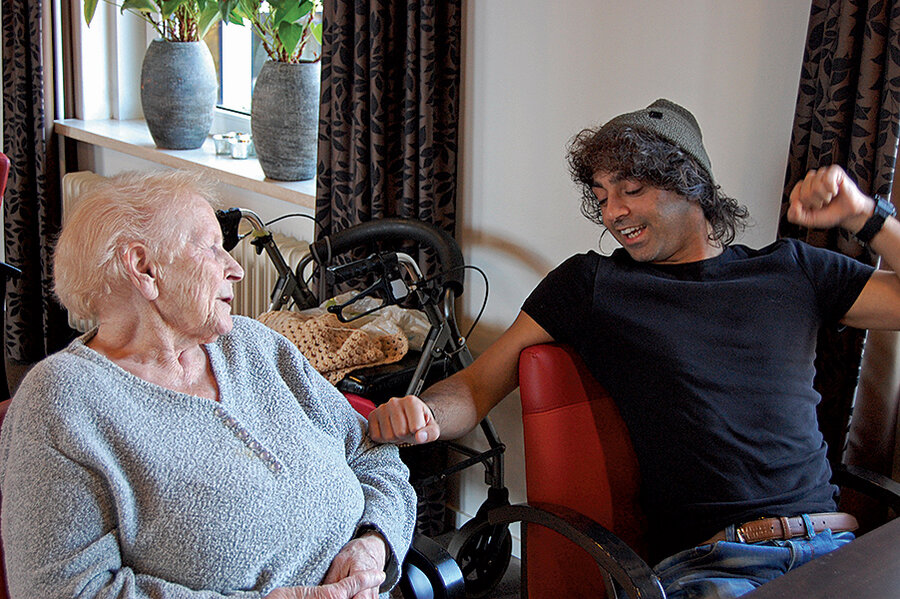How adding youth to a Dutch old age home is improving life for all
Loading...
| Deventer, Netherlands
A World Living Longer: Global aging is one of the greatest challenges of the century. And this is not just a “Western” problem. Politicians and policy makers around the world are rethinking healthcare networks, urban design, nursing care, and pension systems to prepare for it. The elderly themselves are key players to help turn this from challenge to opportunity.
For more in the Monitor's look at global aging issues and solutions, please visit our series homepage.
It’s not every day that someone living in a retirement home break-dances his way to a TV game-show prize by hopping upside-down on his right hand 75 times in less than two minutes.
But Sores Duman, who managed that feat earlier this month, is not your everyday retirement home resident. He is a 27-year-old student, one of six living at the Humanitas nursing home in this provincial Dutch town who are blowing a blast of fresh air through a traditionally sleepy institution.
“Old people can feel cut off from society,” explains Mr. Duman, his bushy black hair springing out from under a beanie. “We bring the outside world inside. We bring some joy and excitement.”
And the older residents seem to love it. “Without them it would be boring here,” says Annie Middelburg, an 85-year-old doing some knitting by a picture window one recent autumn afternoon. “It’s a lot happier than before.”
Humanitas is pioneering a movement catching on around the world, from Cleveland to Helsinki: intergenerational living. Studies have shown that social isolation and loneliness among the elderly are killers; contact with younger people is good for their health.
And contact with older people is good for the students too. “We get lessons in life that we wouldn’t get in normal student housing,” says Patrick Stoffer, a young man in his final year of facility management studies. “Living here gives you a different perspective; it has definitely changed me for the better.”
Good neighbors
Once upon a time, growing up with your grandparents around was the norm in Europe and the United States. In many parts of Africa and Asia, it still is.
For Gea Sijpkes, Humanitas director, the intergenerational approach was a solution to two problems. On the one hand, she says, cost-cutting reforms of the Netherlands’ care homes “made me re-think what business I was in and I decided I was in the happiness business.
“Maybe I can’t fix your bad knee, but I can make your living environment warm, funny, and surprising, a place you’d want to be,” she adds.
At the same time, the state was cutting back on student grants. So Dr. Sijpkes offered rent free rooms in her care home to local students, in return for 30 hours a month of being a “good neighbor,” brightening the place up.
Not without opposition from her board. “To them, students meant sex, drugs, and rock ’n’ roll,” Sijpkes recalls. “How could I think of letting them live among the vulnerable elderly?”
As long as the students keep the sex, drugs, and rock ’n’ roll behind the closed doors of their rooms, they are obeying the only house rule: Don’t be a nuisance. And since the first student moved in four years ago, they have discovered that being a “good neighbor” means a lot more than just helping serve high tea each afternoon.
It means being visible and ready to spend some time with the older residents, whether it is spent watching a soccer match or painting an old lady’s nails. “It’s socializing, saying hello, stopping for a chat, and you find you both have a smile,” says Mr. Stoffer.
“Since I had a fall I’ve lost some of my memory, and sometimes I can’t remember how to work my computer,” says An Bonte, who has lived in the home since April, after volunteering there for 50 years. “Patrick helps me out. And when one of us feels a bit down the students can cheer us up.”
They give the older residents something to talk about, too. It might be the graffiti class that one art student gave – a huge success. Or the pajama party that another student organized (although the old people found that one hard to understand, and most of them came wearing dressing gowns over their normal clothes). Or the hundreds of green balloons that Sijpkes found floating all over the home when she came to work one morning – blown up by students on a whim.
The elderly residents’ most popular topic of conversation, though, is the students’ love lives. “We don’t need to buy magazines,” laughs Ms. Middelburg. “We just talk to the students about what they are up to. It makes me feel younger.”
An idea spreading
Sijpkes says the Humanitas experiment in intergenerational living has drawn “crazy” levels of international interest, with visitors and queries from all over the world. And a number of similar projects are already underway elsewhere.
In Cleveland, Ohio, eight students of music and art live in Judson Manor and Judson Park retirement homes, part of a program that has been running since 2010. In return for free lodging, the music students stage regular recitals and concerts at the homes.
In Helsinki, the capital of Finland, a scheme called “The House That Fits,” aimed primarily at finding affordable housing for young people, has started lodging a handful of 20-somethings in a seniors’ home. They pay a low rent in return for giving five hours a week of their time to their elderly neighbors. The project drew its inspiration from Humanitas.
And for the past 10 years, a French charity “Ensemble2Generations” (Two Generations Together) has been matching older people ready to share their private homes with students in need of somewhere cheap to live. So far, it has placed 3,000 students nationwide with retirees who are happy to have some company.
The benefits to the older people are clear, says Valérie Ernerwein, vice president of the Reims branch of the charity in Eastern France. “On average,” she says, “having a student come to live with you pushes back the need to go into a retirement home by about two years.”
'We’re among equals'
Harry TerBraak, a 90-year-old former hairdresser, says he feels younger because he is treated that way – he doesn’t blink at being greeted with a fist bump, for example, nor look puzzled when Stoffer addresses him as “dude.”
“With the students we’re among equals,” he says. “They do not treat us as if we were old, and that’s really important.”
That’s something that Duman has learned over the nine months he has lived at the nursing home.
“I used to look at elderly people and see their limits, what they couldn’t do,” he remembers. “Now I see their possibilities, what they can do. You have to see them as regular people, not as the elderly.”
And you have to listen to them, too, which is a pleasure, says Jurriën Mentink, an urban design student. “You offer them a cup of coffee and they’ll tell you their life story,” he says, smiling. “That makes my life a lot broader. And we tell them our stories and how the world is changing. They need that, because this place can be a prison if you are not mobile. When we combine our worlds, we get some positive friction.”
For more in A World Living Longer, the Monitor's look at global aging issues and solutions, please visit our series homepage.








